Meeting of the Finance Audit & Risk Sub-committee
Date: Wednesday 22 May 2019
Time: 9.00am
|
Venue:
|
Council Chamber
Hawke's Bay Regional Council
159 Dalton Street
NAPIER
|
Agenda
Item Subject Page
1. Welcome/Notices/Apologies
2. Conflict
of Interest Declarations
3. Confirmation of
Minutes of the Finance Audit & Risk Sub-committee held on 12 February 2019
4. Follow-ups from
Previous Finance Audit & Risk Sub-committee Meetings 3
Decision Items
5. Rating Invoice
– Proposed Issue, Due and Penalty Date Changes 7
6. Proposed Schedule
of 2019-2020 Internal Audits 21
Information or Performance Monitoring
7. Water Management
Follow-up Internal Audit Report 45
8. Draft 2019-20
Annual Plan 69
9. Living Wage Update 71
10. Procurement and Contract
Management Update 75
11. May 2019 Sub-committee Work
Programme Update 79
13. Treasury
Report (late item to come)
Decision Items (Public Excluded)
12. Proposed 2019-20 Council
Insurance Programme 81
HAWKE’S BAY REGIONAL COUNCIL
Finance
Audit & Risk Sub-committee
Wednesday 22 May 2019
SUBJECT: Follow-ups from Previous Finance
Audit & Risk Sub-committee Meetings
Reason for Report
1. In order to track items raised at previous meetings that require
follow-up, a list of outstanding items is prepared for each meeting. All
follow-up items indicate who is responsible for each, when it is expected to be
completed and a brief status comment. Once the items have been completed and
reported to the Committee they will be removed from the list.
Decision
Making Process
2. Council is required to make every decision in
accordance with the Local Government Act 2002 (the Act). Staff have assessed
the in relation to this item and have concluded that as this report is for
information only and no decision is required, the decision making procedures
set out in the Act do not apply.
|
Recommendation
That the Finance, Audit and Risk Sub-committee receives
and notes the report “Follow-ups from Previous Finance Audit and
Risk Sub-committee Meetings”.
|
Authored by:
|
Leeanne
Hooper
Principal Advisor Governance
|
|
Approved by:
|
James Palmer
Chief Executive
|
|
Attachment/s
|
⇩1
|
Follow-ups
from Previous FARS Meetings
|
|
|
|
Follow-ups
from Previous FARS Meetings
|
Attachment 1
|


HAWKE’S BAY REGIONAL COUNCIL
Finance
Audit & Risk Sub-committee
Wednesday 22 May 2019
Subject: Rating Invoice –
Proposed Issue, Due and Penalty Date Changes
Reason for Report
1. This report
proposes a change to the date Hawke’s Bay Regional Council’s rate
invoices are sent out and the date payment is due with the objective of
improving Council’s cash flow and removing the payment pressure on
ratepayers over the Christmas period.
2. It provides the
Finance, Audit and Risk Sub-committee (FARS) the opportunity to review the
proposal and if supportive, make a recommendation to the Corporate and
Strategic Committee.
Background
3. An opportunity
has been identified to improve HBRC’s cash flow through adjustments to
the date rates assessment/invoices are sent out and the date payment is due.
4. Currently rates
invoices are sent out mid-September and due 1 October each year, however HBRC
allows ratepayers until 31 January to pay before a penalty is applied.
5. Rates are the
main direct source of income for Council. Typically Council receives
approximately 6-8% of rates revenue in October, with approximately 70% of the
rates revenue collected in January and February - seven to eight months into
the financial year. (Please see Attachment 1 for the rates payment trends for
the past three years.)
6. HBRC’s
history of having a due date (1 October) and then a final date for payment
(31 January) for rates is understood to have come from the time when HBRC
was a County Council. The Council at that time extended the timeframe for
payment to accommodate the rural sector who needed to wait for their wool
payments which arrived in January.
Proposal
7. This paper is
proposing Council send out rates invoices earlier and bring the date forward
for when payment is required. (Please see Table 8.1 below for the current dates
and proposed changes.) It is also proposed to have one payment date only
– so the due date and final date for payment is the same. Having
one due date is in line with how Territorial Local Authorities apply their
invoices.
Table
8.1: Current dates and proposed changes
|
|
Current dates
|
Proposed dates for 2020-21
|
|
Date rating
information is sent to NZ Post, Christchurch
|
31 August
|
Last week of
July
|
|
Date rates
invoices are sent out
|
Mid-September
|
Early to
mid-August
|
|
Rate
assessment/invoice date
|
1 October
|
20 September
|
|
Date invoice
payments are due
|
1 October
|
20 September
|
|
Date for
final payment
|
31 January
|
20 September
|
|
Date for
applying penalties
|
1 February
|
21 September
|
8. The
intention is for ratepayers to receive their invoice four to six weeks before
it is due to be paid (currently ratepayers have 17 weeks). Legislation requires
the ratepayer to receive the invoice 14 days before the due date.
9. The idea of
moving the date invoices are sent out and the date payment is due has
previously been discussed at a Council Long Term Plan (LTP) workshop on 11
October 2017 where potential efficiencies across the business were presented to
Councillors.
10. Also introduced at this
workshop was the option of adding a second penalty of 10% on total rates
outstanding (including penalties) as allowed as per the local Government
(Rating) Act 2002.
11. In the 2018-28 LTP Council
stated we would investigate the rating date changes and implement the
additional penalty. The following are extracts from the 2018-28 LTP.
Rate invoicing period change
It is proposed that during the 2018-28
LTP period HBRC will investigate changing the date that rate invoices are sent
out and the final due date each year.
Additional penalties to be added from July 2019
All outstanding rates including
previous penalties as at 1 July each year will now have a penalty of 10% added
to those rates. This penalty will be added on the first working day after 1
July each year.
12. A 10% penalty is being
implemented from 1 July 2019. This has also been notified on the current
years’ invoice.
Aim of changing the
dates
13. The main aim of changing
the date rate invoices are sent out and the payment date is to improve
Council’s cash flow.
14. The aim is to also shorten
the payment period and eliminate the final date for payment. This means
ratepayers would have one due date for payment (20 September).
15. It is hoped the new issue
and payment dates can be implemented for the 2020-21 year with promotion of the
new dates starting this year. This means the dates for next year’s
rates for 2019-20 will remain the same.
16. The intention is to also
redesign HBRC’s rate invoice to reflect Council’s new branding and
provide a cleaner invoice, while still meeting the legislative requirements.
Benefits of
changing the dates
17. Improved cash flow - by
moving the due date and having just one payment date, we are hoping to receive
the 70% of rates revenue several months earlier than we currently do.
17.1. As shown in Attachment
1, Council invoiced a total of $24,240,753 in rates for the 2017-18 financial
year and received approximately 70% ($15,569,677) in January/February. In the
current financial year (2018-19) $27,280,369 was invoiced and $18,908,917 was
received this January/February.
17.2. The earlier Council
collects the rates revenue, the earlier it can be invested or used to fund
operational expenses.
18. Less debt funding –
if required to cover cash flow shortfall periods.
19. Less penalty and simpler
payment for ratepayers.
19.1. While the proposed
changes might be viewed negatively by some, the change may be welcomed as
helping ease the frustration of some ratepayers. Every year the rates team gets
frustrated ratepayers calling once the penalty has been applied to their
invoice to say they forgot to pay their rates because of the long time span
between the issue and final due date.
19.2. The intention is to
provide ratepayers with a 12-month direct debit payment option which may assist
the ratepayer with better budgeting. Currently ratepayers have a three-month
direct debit option and a once-yearly option on 31 January. Some ratepayers
choose to pay through automatic payments. Ratepayers who pay by direct debit
will not be charged any penalty.
20. Better timing for
ratepayers.
20.1. Ratepayers tell Council
staff the timing of the final payment date, 31 January, is not ideal;
citing Christmas, holidays and expenses relating to the start of the new school
year. Although suggested that they can pay the rates earlier many prefer to pay
on the last possible date.
21. Will reduce staff time
spent taking phone calls from ratepayers checking to see if they have paid
their rates, and re-printing and sending out invoices on request due to the
long timespan between receiving the invoice and the final date for payment.
22. Provides Finance and
Rating staff the opportunity to take more leave during the school holidays and
Christmas period.
Risks/Issues of Changing the Dates
23. Public Perception
23.1. Ratepayers, for
budgeting purposes, will be receiving two rate invoices in one calendar
year – although the invoices cross over two financial years. It is vital
that the changes, if approved by Council, are communicated early and clearly
both internally and externally. A communications plan will be developed and
implementation will start the day Councillors adopt the proposal (if they
choose to adopt) to allow a good lead in time for the ratepayers.
24. Election Year
24.1. Due to it being it an
election year it may be that Councillors are not keen to approve the proposed
date changes. Should this be the case, the intention would be to implement the
changes for 2021-22, following approval from Council.
25. Transition Period
25.1. It is acknowledged it
may take two years before we receive the full targeted 70% earlier. People who
are currently on payment plans may take a longer period to adjust.
25.2. More penalties may need
to be remitted in the first year of implementation due to an unbudgeted change
for ratepayers. Council currently has a remission policy of one penalty
remittance allowed every three years. If this proposal is approved,
Council will develop a one-off additional penalty remission policy to take place
in the first year of implementing the new dates. This will enable previously
remitted ratepayers not to be financially punished while this change is being
implemented.
Consultation
26. External advice has been
sought in regards to determining the need for community consultation in
changing the collection and penalty dates.
27. Philip Jones of PJ and
Associates[1]
has advised (please see Attachment 2) there is no legal requirement under
either the Local Government (Rating) Act 2002 (LGRA) or the Local Government
Act 2002 (LGA) for Council to consult on changing the due or penalty dates
(When setting the due and penalty date a local authority must follow the
requirements of both these acts.)
28. As noted in point 11 it
was stated in Council’s 2018-28 LTP HBRC will investigate changing the
date that rate invoices are sent out and the final due date each year.
29. Philip Jones advises that
a significant change in the due dates and associated penalty date would have to
be considered against the Council’s Significance and Engagement Policy.
He advises the proposed changes would be considered a minor decision and
therefore does not require further consultation via public meetings. However,
because of the ratepayer’s impact, Council should provide a long lead in
time before implementing the proposal.
30. Staff have also considered
Council’s Criteria for Significance, in particular:
30.1. The likely impact or
consequences for affected individuals and groups in the region
30.2. The impact on rates or
debt levels
30.3. The cost and financial
implications of the decision to ratepayers
31. Is it acknowledged there
will be some ratepayers who be significantly impacted by the earlier payment
due date. The intention is to identify the 200 highest ratepayers in each
district and contact them personally in writing to explain the changes, outline
payment options, and potential remission of penalties for the implementation
year.
Financial and Resource Implications
32. A project team has been
established with Project Manager Mandy Sharpe (from the Project Management
Office) and Principal Accountant Rates and Revenue Trudy Kilkolly leading the
project. Within this team are staff from Communications, Rates, Finance and
ICT.
33. Regular meetings/workshops
will be held to ensure the process is rolled out as smoothly as possible,
identifying and managing any issues.
34. Estimated costs that this
project will incur include:
34.1. Implementation of a
communication/advertising campaign - $15,000.
34.2. Software changes (@
$205.00/ hr) to allow the development of a new rates invoice template and to
enable the 12-month direct debit facility to be added to our system. It
is not known at this stage how long this will take.
34.3. Consultant fees for peer
review and development of remission policy - $5,000.
34.4. Re-design of new invoice
- $5000-$7000.
34.5. Increased staffing
levels for short fixed term period to deal with ratepayers queries in relation
to the change in payment times and/or payment structure $10,000-$15,000
34.6. Possible increase in
penalty remissions for the first year of implementation. (Last year 9,992
ratepayers received a penalty with 14% written off).
Decision Making
Process
35. Council and its committees
are required to make every decision in accordance with the requirements of the
Local Government Act 2002 (the Act). Staff have assessed the requirements in
relation to this item and have concluded:
35.1. The decision does not
significantly alter the service provision or affect a strategic asset, and is
not inconsistent with an existing policy or plan.
35.2. The use of the special
consultative procedure is not prescribed by legislation.
35.3. The decision does not
fall within the definition of Council’s policy on significance.
35.4. The decision of the
sub-committee is in accordance with the Terms of Reference and decision making
delegations adopted by Hawke’s Bay Regional Council 9 November 2016,
specifically:
35.4.1. The purpose of the Audit and
Risk Sub-committee is to report to the Corporate and Strategic Committee to
fulfil its responsibilities for the provision of appropriate controls to
safeguard the Council’s financial and non-financial assets, the integrity
of internal and external reporting and accountability arrangements.
|
Recommendations
1. That the Finance, Audit and Risk Sub-committee receives and notes
the “Rating Invoice – Proposed Issue, Due and Penalty Date
Changes” staff report.
2. The Finance, Audit and Risk Sub-committee recommends that the
Corporate and Strategic Committee:
2.1. Agrees that the decisions to be made are not significant under the
criteria contained in Council’s adopted Significance and Engagement
Policy, and that the Committee can exercise its discretion and make decisions
on this issue without conferring directly with the community.
2.2. Recommends that Hawke’s Bay Regional Council approves the
proposed rates issue, due and penalty dates following, for implementation 1
July 2020.
2.2.1. Invoices sent out – early to mid-August
2.2.2. Rate assessment/invoice date – 20 September
2.2.3. Payment due date – 20 September
2.2.4. Penalty date – 21 September
|
Authored by:
|
Trudy
Kilkolly
Principal Accountant Rates and Revenue
|
Mandy Sharpe
Project Manager
|
Approved by:
|
Jessica
Ellerm
Group Manager Corporate Services
|
|
Attachment/s
|
⇩1
|
Rate Payment
Trends
|
|
|
|
⇩2
|
Letter from
PJ & Associates
|
|
|
|
Rate
Payment Trends
|
Attachment 1
|

|
Letter from PJ &
Associates
|
Attachment 2
|





HAWKE’S BAY REGIONAL COUNCIL
Finance
Audit & Risk Sub-committee
Wednesday 22 May 2019
Subject: Proposed Schedule of
2019-2020 Internal Audits
Reason for Report
1. To propose an
internal audit programme for the 2019-20 financial year for agreement of the
Sub-committee.
Background
2. During the
current financial year HBRC’s internal auditors, Crowe Horwath, have
conducted a series of internal audits including:
2.1. Data
Analytics
2.2. Health &
Safety
2.3. Water
Management Follow-up.
Options Assessment
3. In consultation
with Crowe Horwath, and based on HBRC’s risk register, staff recommend
the following internal audit programme for the 2019-20 financial year.
3.1. IT Security
3.2. Data
Analytics
3.3. Risk
Management
3.4. Asset
Management.
4. A detailed work
programme which provides an outline of the above proposed and previously
conducted audits is attached.
5. IT security has
been proposed due to the benefit of independent advice over how effective HBRC’s
IT controls are. While HBRC believes its controls are effective, IT and cyber
security is an increasingly high risk area for organisations. The review would
include an evaluation of processes, policies, procedures, security controls and
response and recovery programmes. This would also tie in well with a
cyber-security/penetration testing assignment currently underway as part of an
overall IT security review. As this is the first proposed audit in the
programme, a scope is attached for the Sub-committee to review and
approve.
6. Data Analytics
is proposed to be repeated due to the useful information it has provided in its
previous two audits. This also provides the opportunity to benchmark
improvements made to processes since prior audits. As this audit has been
performed previously, the cost and staff time involved will be reduced.
7. Risk Management
has been proposed due to its evolution and development over the past two years
to ascertain how effective risk management processes are, along with areas for
improvement.
8. Asset
management has been proposed as there hasn’t been an audit of this
activity in recent years. The audit would include areas such as a review of the
maturity of asset management controls in areas such as asset management policy
and strategy, accuracy of data, asset lifecycle decision making, and asset
performance and condition. Areas such as leadership, planning and continuous
improvement would also be assessed.
9. All of these
areas are recommendations at this stage and staff will take any guidance from
the Sub-committee for additional or reprioritising topics, as well as refining
of scope.
Financial
and Resource Implications
10. Staff confirm that the
schedule of internal audits as proposed is accommodated within existing budgets
as set by the 2018-28 Long Term Plan, however if the sub-committee wishes to
consider additional work in this area budget allocations may require
reconsideration.
Decision Making
Process
11. Council
and its committees are required to make every decision in accordance with the
requirements of the Local Government Act 2002 (the Act). Staff have assessed
the requirements in relation to this item and have concluded:
11.1. The decision
does not significantly alter the service provision or affect a strategic asset,
and is not inconsistent with an existing policy or plan.
11.2. The use of
the special consultative procedure is not prescribed by legislation.
11.3. The decision
does not fall within the definition of Council’s policy on significance.
11.4. The decision of
the sub-committee is in accordance with the Terms of Reference and decision
making delegations adopted by Hawke’s Bay Regional Council
9 November 2016, specifically:
11.4.1. The purpose
of the Audit and Risk Sub-committee is to report to the Corporate and Strategic
Committee to fulfil its responsibilities for the independence and adequacy of
internal and external audit functions.
11.4.2. The
Finance, Audit and Risk Sub-committee shall have responsibility and authority
to confirm the terms of appointment and engagement of external auditors,
including the nature and scope of the audit, timetable, and fees.
|
Recommendations
1. That the Finance, Audit and Risk Sub-committee:
1.1. receives and considers the “Proposed
Schedule of 2019-2020 Internal Audits” staff
report.
1.2. Agrees to the 2019-20 schedule of Internal Audits, including
associated budget allocations, being:
1.2.1. IT
Security
1.2.2. Data
Analytics
1.2.3. Risk
Management
1.2.4. Asset
Management.
2. The Finance,
Audit and Risk Sub-committee recommends that the Corporate and Strategic
Committee takes note of the agreed 2019-20 schedule of Internal Audits within
associated budget allocations.
|
Authored by: Approved
by:
|
Melissa des
Landes
Acting Chief Financial Officer
|
Jessica
Ellerm
Group
Manager Corporate Services
|
Attachment/s
|
⇩1
|
Draft
Proposed 2019-20 Internal Audit Plan
|
|
|
|
⇩2
|
2020 Cyber
Security Planning Memo - Draft for discussion
|
|
|
|
Draft
Proposed 2019-20 Internal Audit Plan
|
Attachment 1
|



|
Draft
Proposed 2019-20 Internal Audit Plan
|
Attachment 1
|









|
Draft
Proposed 2019-20 Internal Audit Plan
|
Attachment 1
|

|
2020
Cyber Security Planning Memo - Draft for discussion
|
Attachment 2
|







HAWKE’S BAY REGIONAL COUNCIL
Finance
Audit & Risk Sub-committee
Wednesday 22 May 2019
Subject: Water Management
Follow-up Internal Audit Report
Reason for Report
1. To provide the sub-committee with the results of the follow-up Water
Management internal audit undertaken by Crowe Horwath.
Background
2. The Finance,
Audit and Risk sub-committee agreed at its meeting on 9 September 2017 to
include Water Management as part of the internal audit work programme. After a
series of iterations, the scope was agreed at the Regional Council meeting on
31 January 2018.
3. The initial Water Management Audit was presented to the Finance,
Audit and Risk Sub-Committee in June 2018
4. As part of its internal audit programme a review has now been
undertaken by Crowe Horwath and the findings presented as attached for the sub-committee’s
consideration.
Decision Making
Process
5. Staff have
assessed the requirements of the Local Government Act 2002 in relation to this
item and have concluded that, as this report is for information only, the
decision making provisions do not apply.
|
Recommendation
That the Finance, Audit and Risk
Sub-committee receives and notes the “Water
Management Follow-up Internal Audit Report”
staff report.
|
Authored by:
|
Malcolm
Miller
Manager Consents
|
|
Approved by:
|
Liz Lambert
Group Manager Regulation
|
|
Attachment/s
|
⇩1
|
Crowe Horwath
Follow-up Water Management Audit report
|
|
|
|
Crowe
Horwath Follow-up Water Management Audit report
|
Attachment 1
|

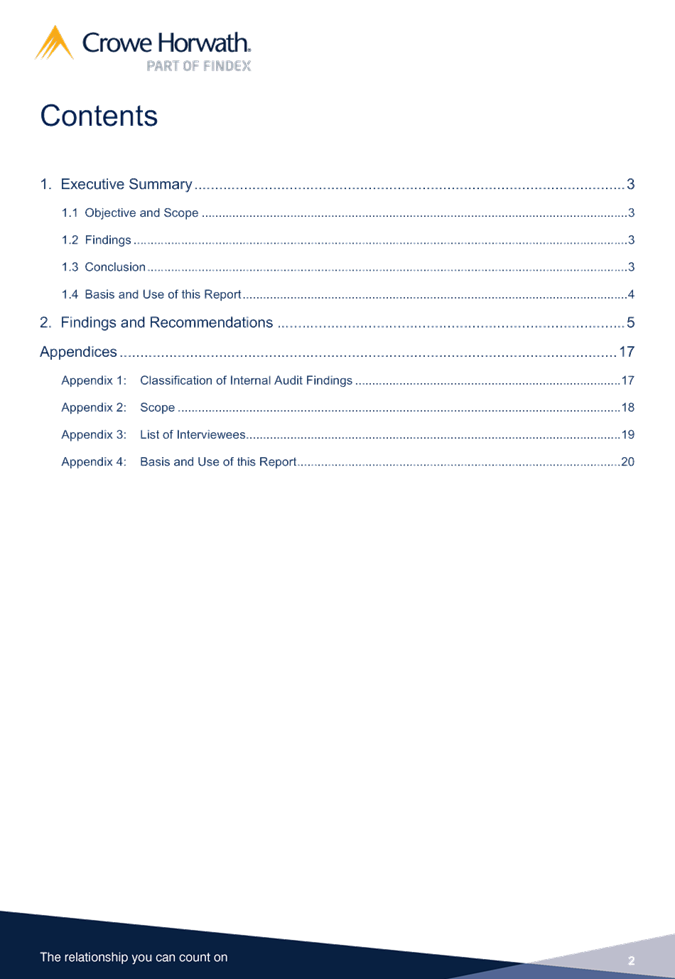
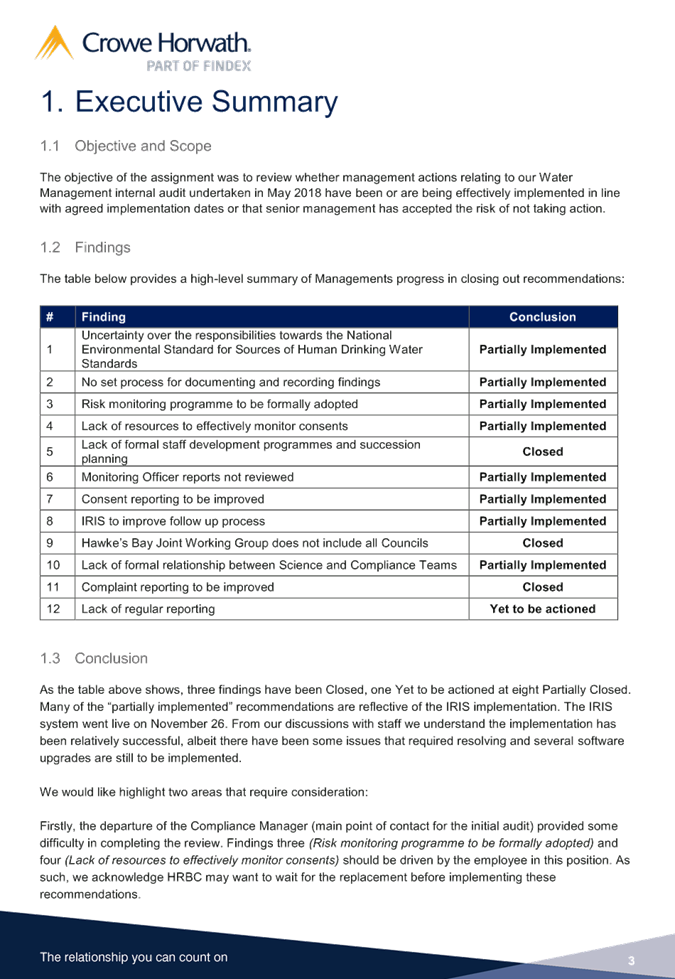

|
Crowe
Horwath Follow-up Water Management Audit report
|
Attachment 1
|
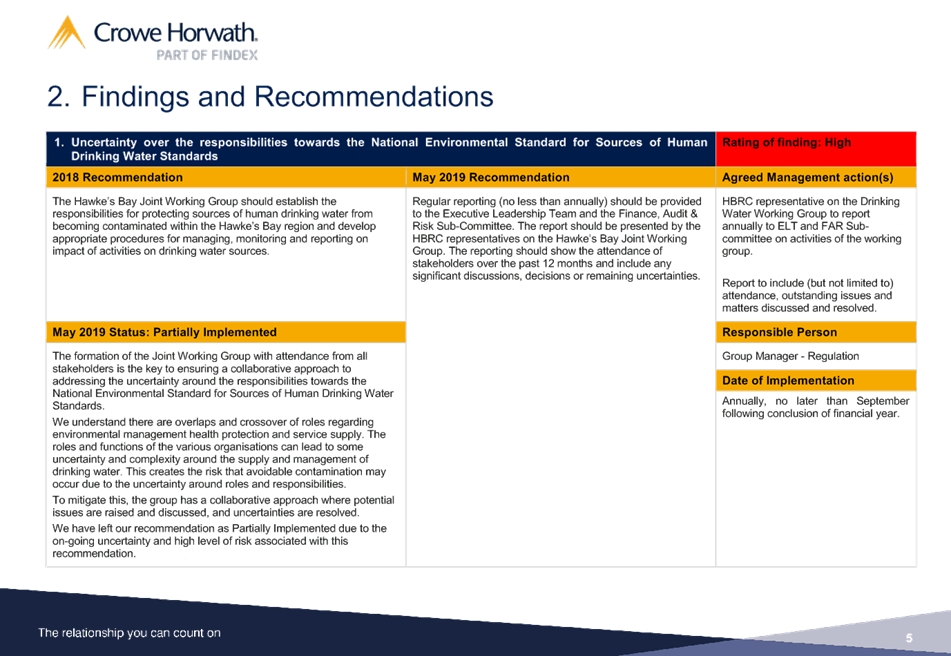
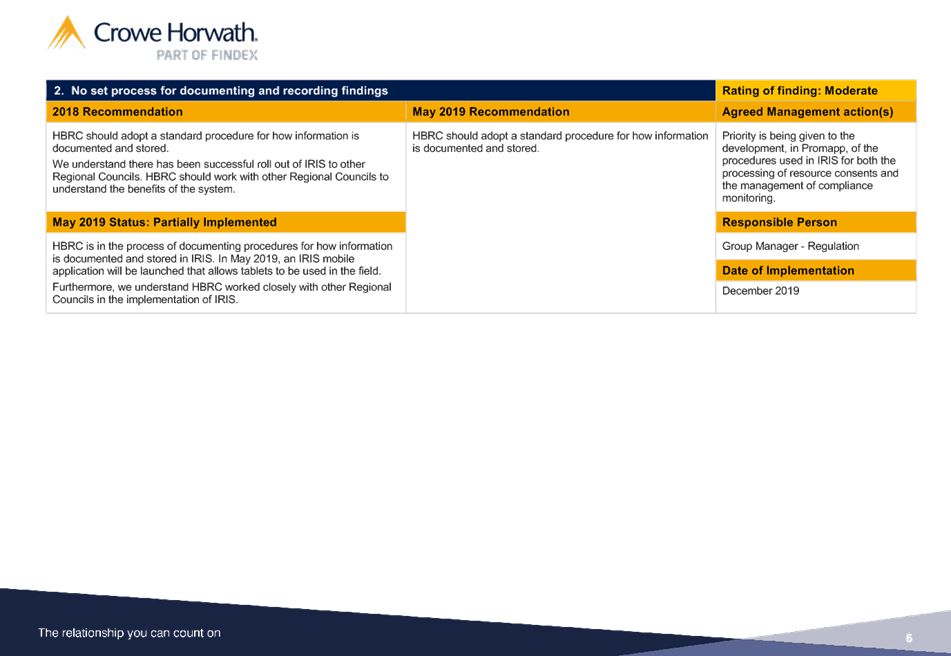
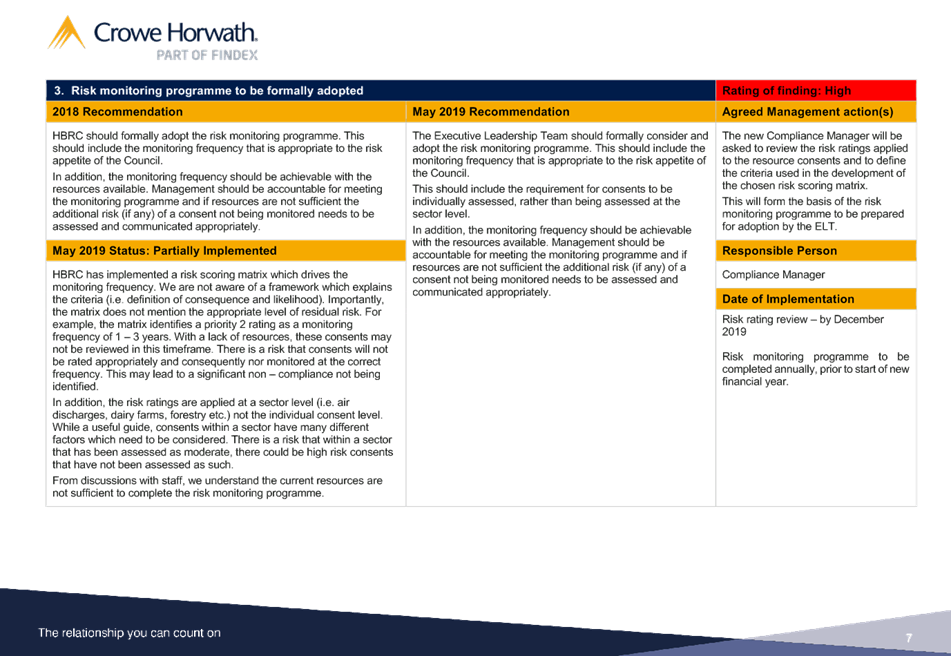
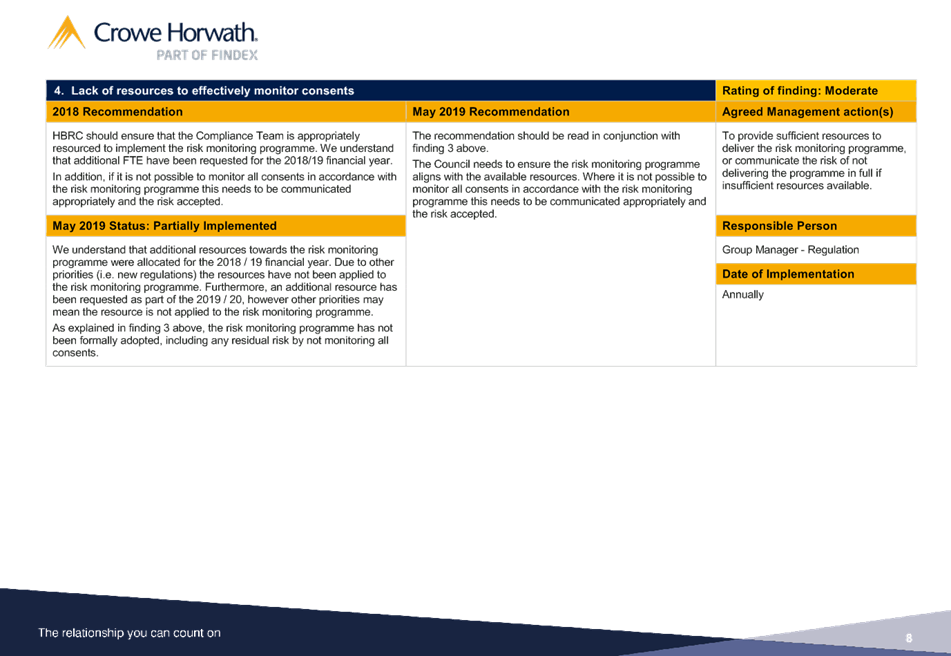
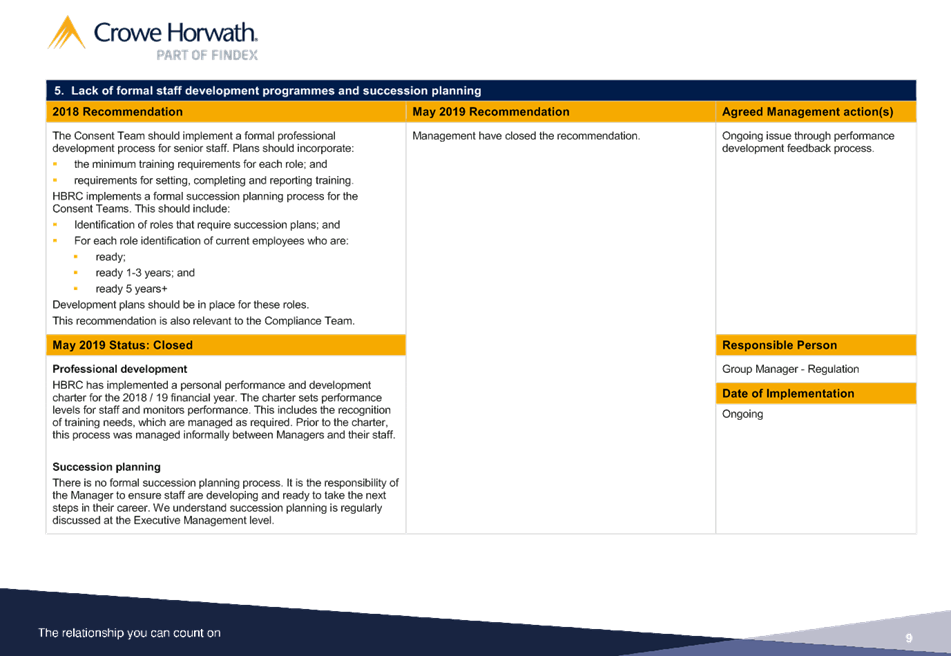

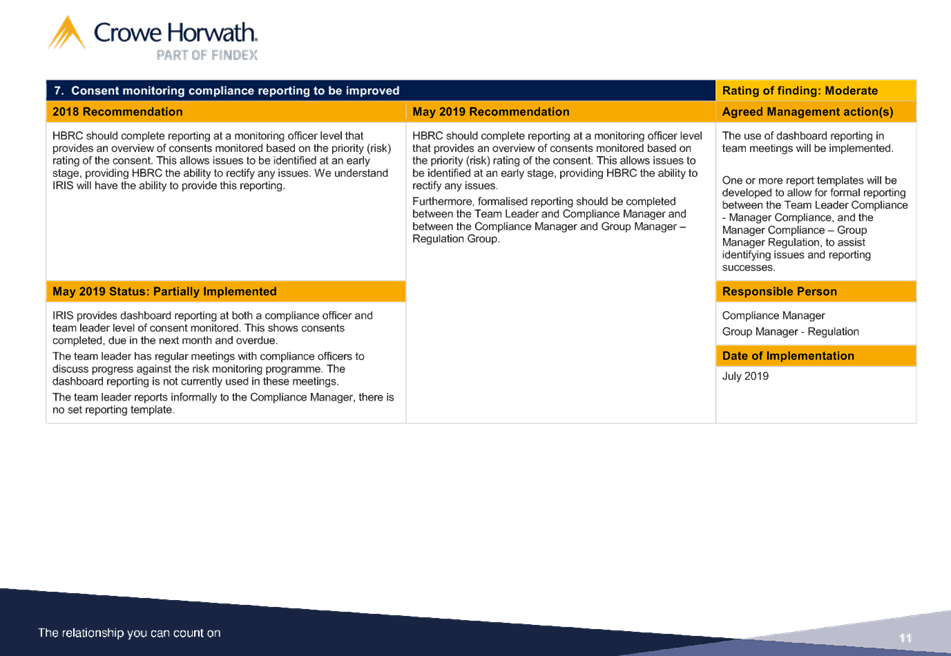
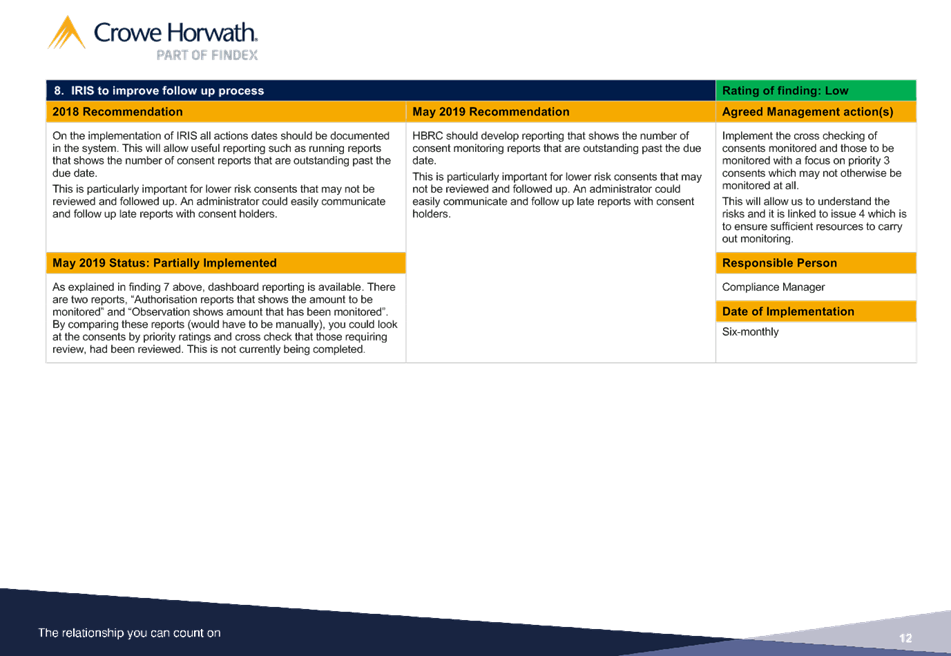

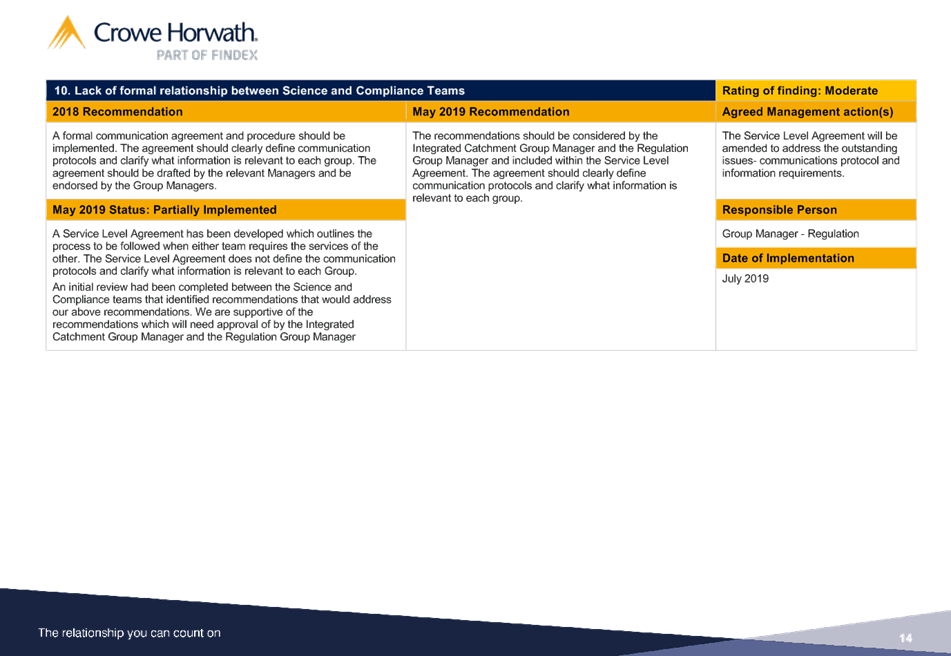
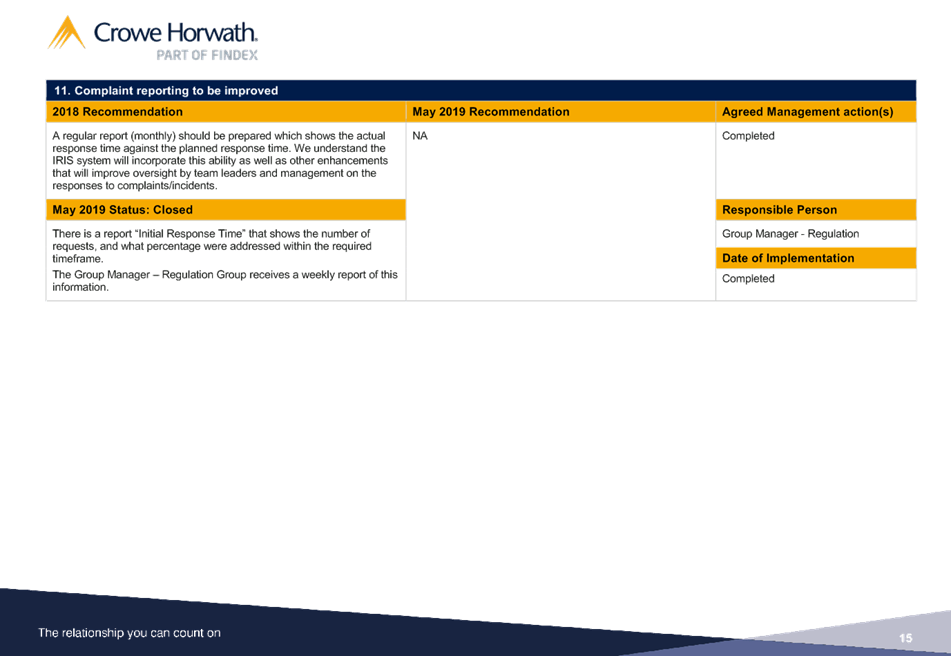
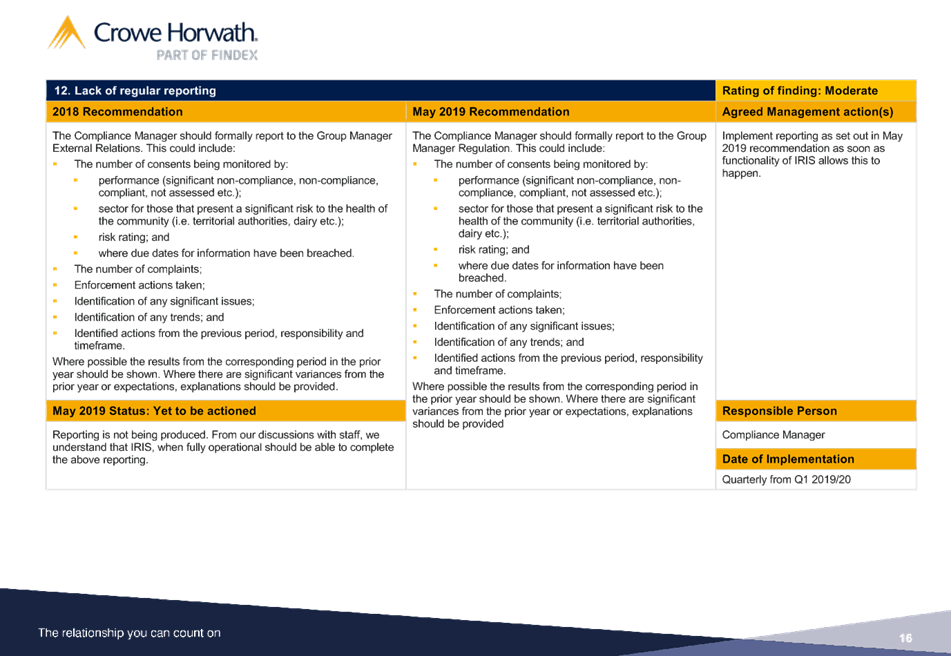
|
Crowe
Horwath Follow-up Water Management Audit report
|
Attachment 1
|
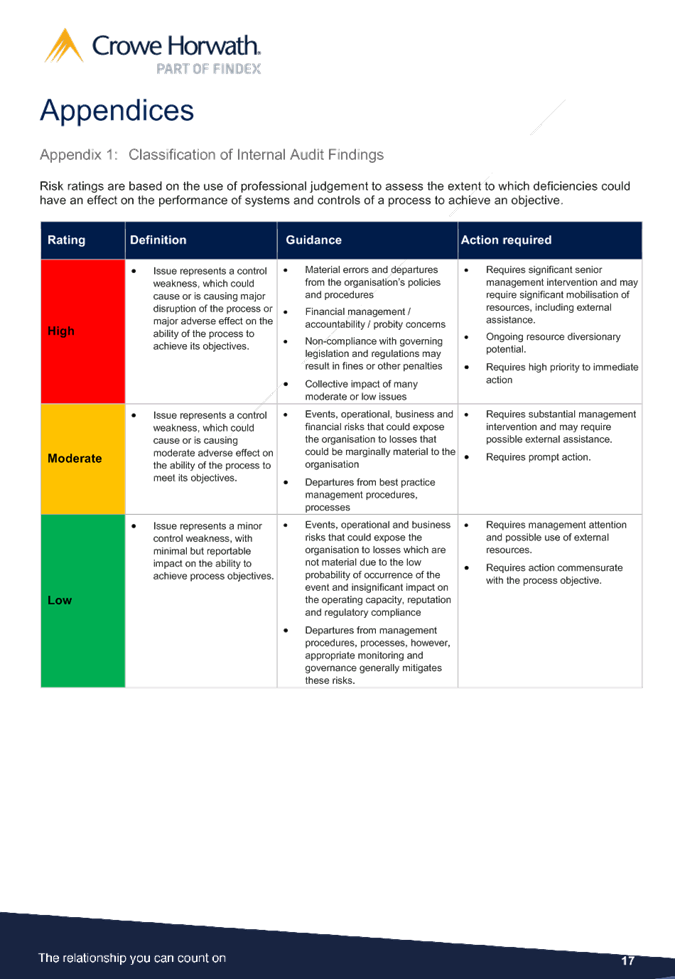
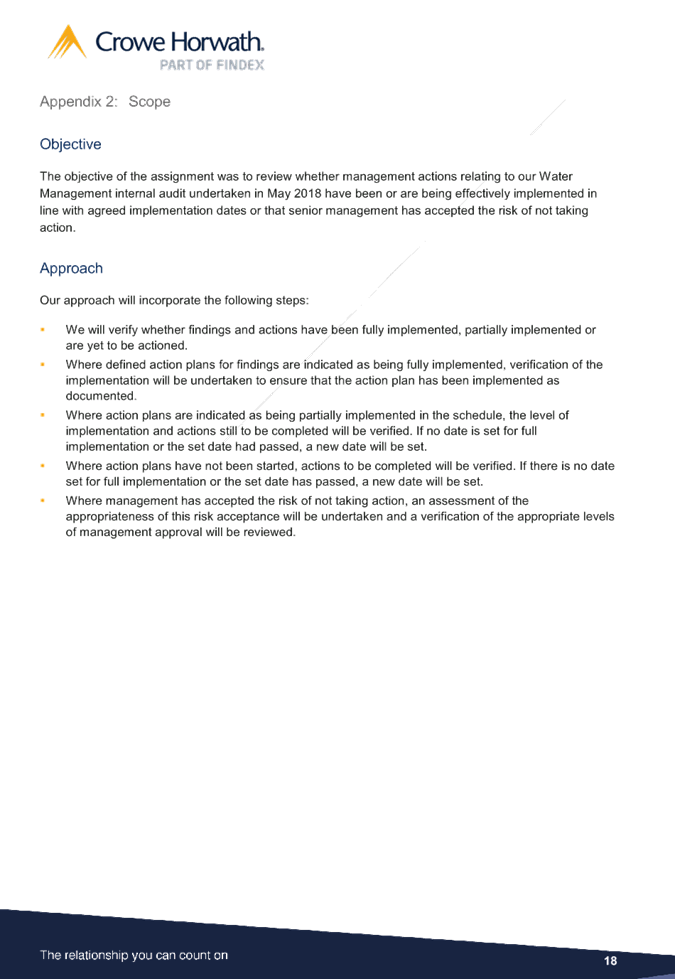
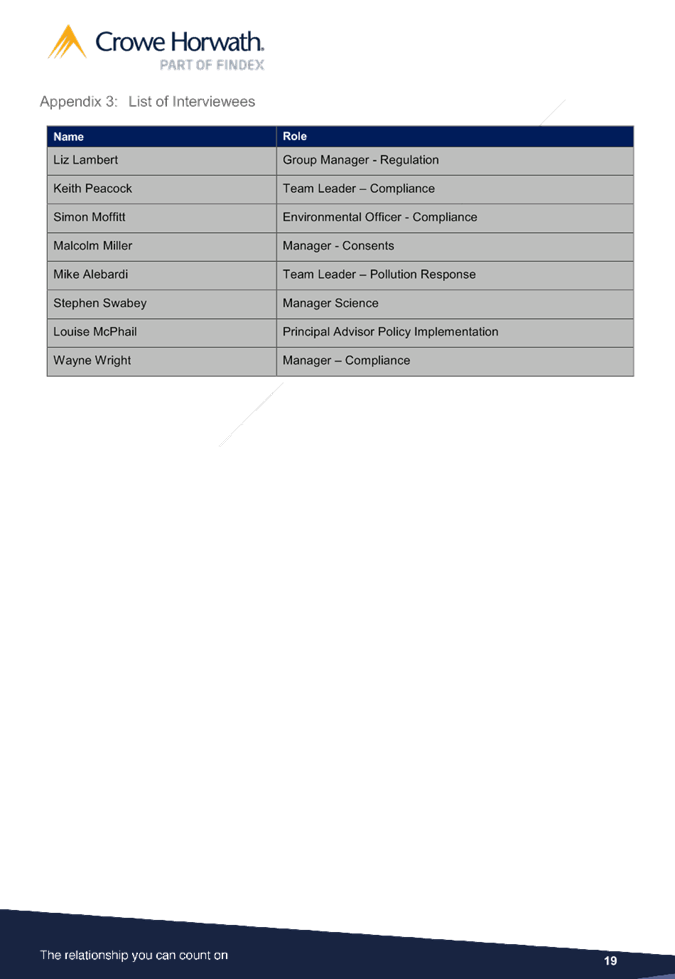
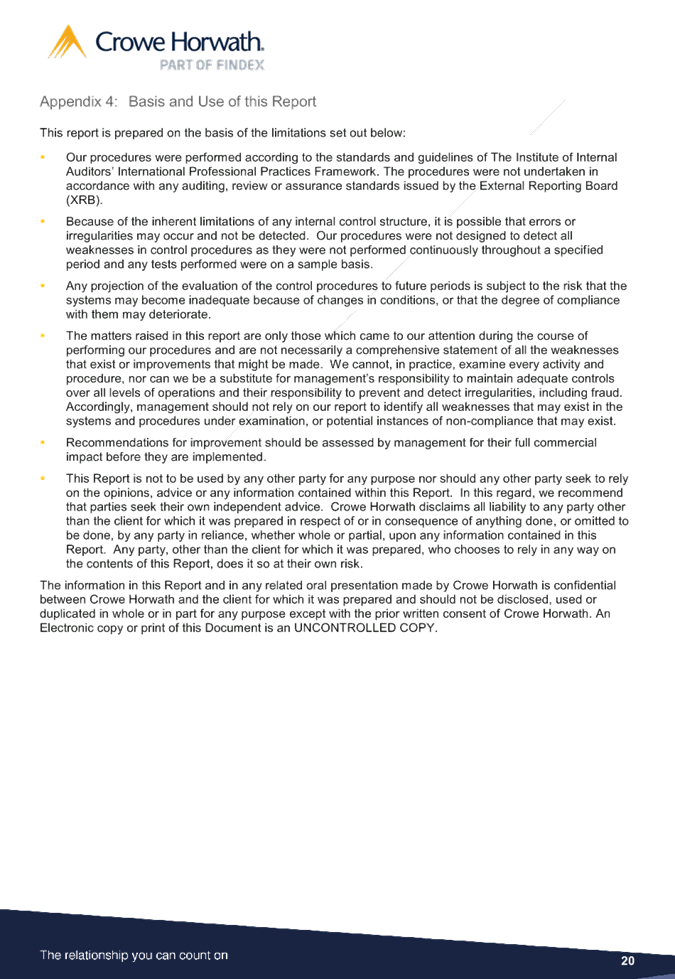
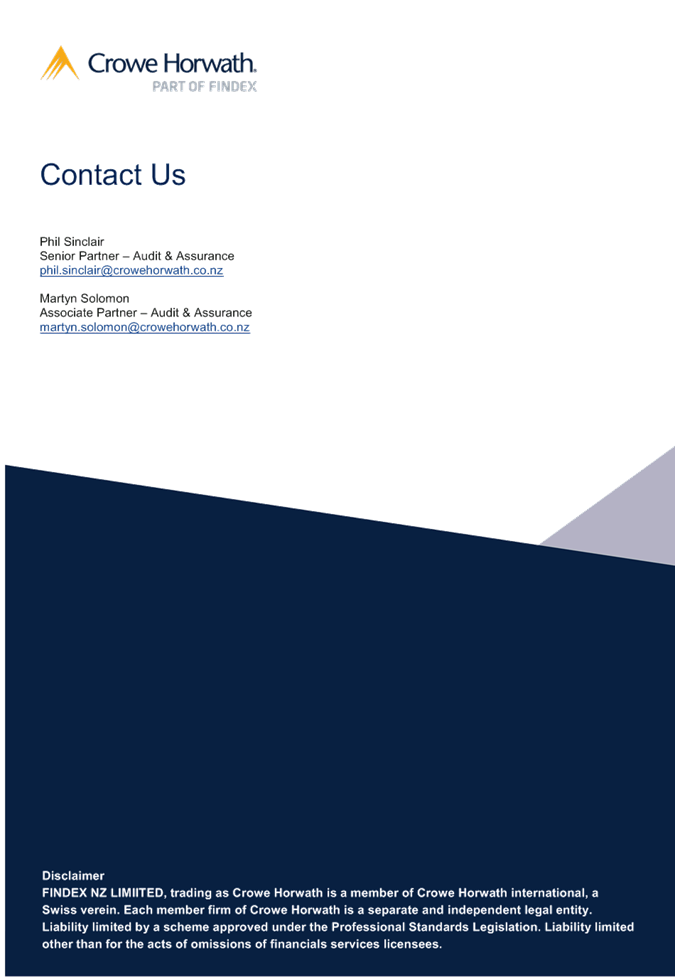
HAWKE’S BAY REGIONAL
COUNCIL
Finance
Audit & Risk Sub-committee
Wednesday 22 May 2019
Subject: Draft 2019-20 Annual Plan
Reason for Report
1. The Annual Plan for 2019-20 is attached for review and
feedback. It will then go to the Corporate and Strategic Committee on 05
June for final adoption by Council for 26 June 2019.
Background
2. The Annual Plan 2019-20 represents year 2 of the Long Term Plan
(LTP) and as the forecasted rates increase of 7.9% has not changed, nor were
there any material or significant differences to what was forecast, the Council
has decided not to consult.
3. The Annual Plan document has three sections:
3.1. Section 1: Introduction
3.2. Section 2: Highlights
3.3. Section 3: Financial information
4. A draft of sections 1 and 2 were presented to Council in a workshop
early March. A media release on 18 April signified our non-consultation
approach and provided a high level overview to the public.
5. A detailed two page spread of key highlights will be published
(through newspapers and social media) in early June to inform the community.
6. A timeline of events for the Annual Plan is below.

Decision Making
Process
7. Staff have
assessed the requirements of the Local Government Act 2002 in relation to this
item and have concluded that, as this report is for information only, the
decision making provisions do not apply.
|
Recommendation
That the Finance, Audit and Risk
Sub-committee receives and considers the Draft
2019-20 Annual Plan and provides feedback to staff.
|
Authored by:
|
Karina
Campbell
Senior Project Manager
|
Melissa des
Landes
Acting Chief Financial Officer
|
Approved by:
|
Jessica
Ellerm
Group Manager Corporate Services
|
|
Attachment/s
|
⇨1
|
First Draft
2019-20 Annual Plan
|
|
Provided to FARS members only
|
HAWKE’S BAY REGIONAL
COUNCIL
Finance
Audit & Risk Sub-committee
Wednesday 22 May 2019
Subject: Living Wage Update
Reason for Report
1. To provide the Sub-committee with a report that breaks down the type
and value of suppliers used by Council for review and consideration. This is
provided in conjunction with any other relevant Living Wage updates since
previous meetings.
Background
2. A procurement internal audit was completed and presented to FARS 6
June 2018, which included an extension to consider the implications behind
implementing a Living Wage requirement. This Living Wage memorandum traversed
the key issues behind implementation of a living wage, such as legal and
financial challenges. The memorandum also noted the benefits of implementing a
Living Wage, such as the recognition of the dignity of work and ability to earn
a living.
3. The Finance, Audit and Risk Sub-committee (FARS) requested at its
meeting on 21 November 2018 that staff prepare further analysis of the
types of suppliers (direct and indirect) Council engages with in the
procurement of its goods and services. This analysis would attempt to quantify
the cost of implementing or preferencing living wage suppliers and how it could
be implemented by way of policy.
4. Finally there was also an analysis of other Councils’ stances
on the living wage, whereby the overarching theme was that most Council’s
elected to only pay the living wage under certain criteria, such as to direct
staff only.
5. This report was then presented to the 12 December 2018 Corporate and
Strategic Committee meeting, where after extensive discussion it was agreed to
await the results of a national review of the Public Transport Operating Model
(PTOM) which is currently underway.
6. The above report was presented in conjunction with other work that
Council has previously provided to FARS in relation to GoBus and staff and a
further update on this and other relevant updates is provided at this meeting.
7. Over the last quarter, staff have conducted a survey of a sample of
direct suppliers to determine likely impacts on requiring them to pay the
Living Wage. The volume of feedback received was disappointing, a full analysis
of the feedback that was received is provided in separate section following.
Council Supplier Analysis
8. Over the past quarter, staff have conducted an analysis of the top
100 suppliers by spend over a 12 month period. From this list a distinction was
made between direct and in-direct suppliers, with direct suppliers being
determined as those whom Council engages on a direct level. For example, a
cleaner who provides their services on site and in person would be deemed
direct, as opposed to a stationary provider who would be deemed indirect.
9. Once this distinction was determined, a total of 65 suppliers from
the top 100 were determined to be direct. A survey was then emailed out
utilising the online survey tool “Survey Monkey” to the direct
suppliers. The disclaimer for the survey stated that Council is reviewing its
procurement policy and was using any responses for information only at this
stage.
10. The
survey was kept brief but included key questions such as whether or not
suppliers pay their staff the living wage. A further question was posed that if
the requirement for suppliers to pay their staff the Living Wage was made a
compulsory, whether that supplier could absorb the costs or if they would need
to pass them on (or a combination thereof). Finally, a question was asked if
this was made a requirement, whether they would still be interested in
continuing business with Council, with room for optional free text comments.
11. There
were only nine responses after the initial email which staff concluded
wasn’t a large enough sample to refelct a fair view. A decision was made
to contact other direct suppliers who Council recognises would traditionally be
the type of service who may traditionally be paid on the lower end of the wage
scale. This included suppliers who Council engages frequently, such as cleaners
and caterers who were not in the preliminary selection.
12. This
direct approach also resulted in a disappointing response rate, with only an
additional four responses, or 13 in total. This poor response may highlight the
reluctance of suppliers to provide sensitive salary information, despite a
clear disclaimer being provided as to how this information would be used.
13. Results
from respondents are as follows:
13.1. Just
over 75% of respondents already pay their staff the Living Wage.
13.2. 100% of
respondents who answered stated that they would continue to provide services to
Council if it was made a requirement for suppliers to pay the Living Wage.
13.3. There
were a mixture of those suppliers who would be able to absorb the costs (29%)
versus those who would need to pass on the cost (43%), with the remainder
stating they would need to pass on a portion of the costs.
13.4. The
cost of the increase in terms of the value of the contract with Council was:
13.4.1. less than
10% (43%)
13.4.2. 10-20%
(57%)
13.4.3. no
suppliers stated that this would cost more than 20%. Note that the survey only
asked for a percentage, as opposed to total costs in order not to make the
survey too cumbersome for respondents.
14. The
optional comments section at the conclusion of the survey provided some
supportive, albeit minimal feedback, with all comments provided being in
positive support of the Living Wage concept and encouraged Council for
conducting a review on this. The following comments were made. “Make the
change to Living Wage,” “I do think this is a necessary step. I
fully support a living wage,” “We totally support the Living Wage
goal, good on you for highlighting this.”
15. Note the
comments above were from suppliers who already pay their staff the Living Wage.
No additional feedback was received from those suppliers that don’t.
16. Overall,
the feedback shows the majority of respondents already pay their staff the
living wage, with around 70% of those that don’t indicating a need to
pass on either a portion, or the entire cost to their customers in order to
operate their business.
17. Given the
relatively small sample size, and the assumption that those suppliers already
paying the living wage could have been more inclined to complete the survey,
the results of the survey are not conclusive enough to make assumptions or
estimates accurate enough to inform decision making. However, based on the
results, staff reviewed the budget for the provision of building maintenance
services, which includes services such as cleaning and catering as noted above
as being types of serviced traditionally in the lower quartile of the wage
bracket. At present, Council currently spends approximately $300k per annum on
such services. A 20% increase on this budget item would cost Council an
additional $60k per annum.
GoBus/PTOM Update
18. At FARS
meeting 21 November, Councillors were advised that staff had been participating
in the national PTOM review which the GoBus contract falls under. Staff were
expecting to have viewed the initial report by this date however Transport
Minister Phil Twyford had indicated that further detailed work would be
required for the report to be more useful and as a result the report is not yet
available.
19. Latest
update from the review is that unions were engaged in November/December 2018,
with research approach agreed in late December. Work on additional research was
launched earlier this year, with report expected to follow. Staff will continue
to provide updates to FARS at each meeting.
National Local Authority Update
20. Council
is currently working with all five local authorities to progress a discussion
on the living wage for internal staff. Councils have agreed to engage an economic
consultant to review this from a Hawke’s Bay perspective.
21. At the
time of writing this report this is still being finalised however initial
indication suggests that every region adopting a common national living wage is
not necessarily an adequate reflection of regional living costs and as such the
report may identify a more appropriate, Hawke’s Bay living wage. This is
similar to an exercise conducted by Palmerston North City Council that
identified a living wage which better reflects regional economies.
22. Council
currently pays all of its permanent staff the living wage or higher.
Central Government Steps
23. Central
Government has recently lifted the minimum wage in New Zealand significantly
which now sits at $17.70 per hour as at 1 April 2019. This is an increase of
$1.20 on previous minimum wage. This increase is the biggest boost to the
minimum wage in recent New Zealand history.
24. In
addition to this increase, Central Government has also promised to increase the
minimum wage further annually for it to reach $20 per hour by 2021.
25. Workplace
Relations and Safety Minister Iain Lees-Galloway has stated that the reasoning
behind this increase is “the Government is determined to improve the
wellbeing and living standards of all New Zealanders as we build a productive,
sustainable and inclusive economy”.
26. At the
time of writing this paper, the Living Wage is currently $20.55 and has been
signalled to increase to $21.15 - with a 1 September 2019 implementation date.
27. The
Living Wage website doesn’t appear to have any commentary on the recent
minimum wage increases at the time of writing this paper.
28. As a
reminder at FARS meeting 6 June 2018, a Living Wage Implications Memorandum was
presented and noted Palmerston North City Council (PNCC) conducted an exercise
to determine a Palmerston North living wage. This was in light of the fact that
the cost of living in this centre was considerably less than the cost of living
in major centres. This determination was set at $17.50.
29. As minimum
wage ($17.70) has now increased beyond the Palmerston North living wage
($17.50), PNCC has elected to drop its local living wage and options to
reassess it further, in recognition of the minimum wage increases.
30. Some PNCC
Councillors noted within their decision making that the increase in the minimum
wage is setting out what the living wage originally planned to do, being
increase the wellbeing and living standards of New Zealanders.
Procurement Options
31. Given the difficulty Council has faced in extracting
supplier wage information, it is hard to determine the real cost impact of the
requirement to include a Living Wage as a minimum requirement as part of
Council’s procurement policy.
32. Staff note that an option may be to encourage
the payment of a living wage within its procurement policy, as opposed to
making it a minimum requirement.
33. The payment of a Living Wage could be given a
weighting however should be weighed up alongside other important factors, such
as buying local, environmental impacts, and good health and safety practices.
For example, a supplier may pay the Living Wage but they may be from a larger
centre. As a result, a local business may miss out on Council’s
business. Due to this staff are not recommending a set weighting and
believe that each contract should be considered on a case by case basis.
Decision Making
Process
34. Staff have assessed the
requirements of the Local Government Act 2002 in relation to this item and have
concluded that, as this report is for information only, the decision making
provisions do not apply.
|
Recommendation
1. That the Finance, Audit and Risk
Sub-committee:
1.1. Receives and notes the “Living Wage Update”
staff report
1.2. Notes that considerations of living wage related procurement
policy decisions are addressed in a separate “Procurement and
Contract Management” item.
1.3. Continues to await the feedback of the Public Transport Operating
Model report.
2. The Finance, Audit and Risk Sub-committee
recommends that the Corporate and Strategic Committee recommends that
Hawke’s Bay Regional Council:
2.1. Considers the addition of a statement in the Procurement Policy
that “Council encourages payment of the Living Wage”
2.2. Recommends that if the inclusion of a weighting for payment of the
Living Wage in a contract decision is to be considered, that decision will be
determined based on the type and value of the contract, and should also weigh
up other best business practices.
|
Authored by:
|
Melissa des
Landes
Acting Chief Financial Officer
|
|
Approved by:
|
Jessica
Ellerm
Group Manager Corporate Services
|
|
Attachment/s
There are no
attachments for this report.
HAWKE’S BAY REGIONAL
COUNCIL
Finance
Audit & Risk Sub-committee
Wednesday 22 May 2019
Subject: Procurement and
Contract Management Update
Reason for Report
1. This report provides an update on progress made in response to
recommendations made by the 2018 internal audit to review and amend the
Regional Council’s Procurement Policy and Procurement Manual.
Background
2. From a purely business perspective, the most obvious benefits of an
effective procurement process are financial, via upfront cost savings by
procuring items, services, and contracts at the best price available. Effective
procurement should also ensure that projects are delivered to time and budget,
with reduced exposure to commercial risk and by way of a consistent and
appropriate process which aligns with HBRC procurement principals.
3. The HBRC Procurement Policy was approved in 2015, the Procurement
Manual was approved in 2016, with the intent to review within three years.
4. In September 2018 The Office of the Auditor General (OAG) and
Ministry of Business Innovation and Employment (MBIE) made new recommendations
for best practice in procurement. HBRC commissioned a review in 2018 by Crowe
Horwath to evaluate our existing policy and make recommendations to align with
current best practice guidelines. This draft policy and the accompanying draft
procurement manual reflect HBRC progress to adopt those and other
recommendations to achieve best practice.
5. The attached revised policy and manual are consistent with national
procurement principles and guidelines and are compliant with relevant
legislation. The Policy details what HBRC is required to do to meet national
guidelines and the Manual details how to apply policy principles, to deliver
benefits of best practice procurement.
6. Key Audit findings from 2018 were:
6.1. Procurement policy (2015) is fit for purpose
6.2. HBRC would benefit from a central Procurement and Contract resource
6.3. There was a lack of evidence to support procurement decisions
(Procurement plans)
6.4. There are inconsistent templates and de-centralised systems for
contract management, with inherent risk.
6.5. Contract register was incomplete and contained expired contracts.
7. Audit recommendations and responses are tabled following.
|
Recommendation
|
Response
|
|
Procurement
structure should be centralised to ensure consistency in the application and
training for best practice
|
1. A procurement hub has now been established as a
central procurement management resource. Staff have created a replacement for
‘contract central’ an Electronic Document Record Management
System (EDRMS) and rather than just being a repository, the new contracts hub
will provide resources to manage the whole procurement life cycle from
planning to evaluation.
2. Specifically, for an organisation of HBRC’s
size and scale, MBIE have informally recommended 1 x procurement FTE to be at
Senior Leadership Team level. This is due to the level of work likely to be
involved, along with the requirement for that person to have sufficient
stature within the organisation to drive results. This role was not included
in the HBRC Long Term plan, but was proposed at the finance audit and risk
committee in June 2018, to be explored for 2020, existing resource being
utilized in the interim.
|
|
Regular
reporting to the Executive team should include high value, high risk or
complex procurement and notice of upcoming significant tenders.
|
A draft
template report will be implemented from June 2019
|
|
A
procurement planning template be included in the procurement manual
|
Plan
templates are included for simple and complex procurements
|
|
Training
should be provided to staff engaged in procurement practice and contract
management
|
Training
will be cascaded from the Hub to selected subject matter experts in each
executive team member group. Each group will include (where relevant)
training for existing staff and new staff as part of the induction process
|
|
Tools and
templates should be implemented to ensure policies and procedures are
followed
|
Procurement
NZ, OAG and MBIE templates are now being introduced as standard across all HB
councils, currently being led by HBRC and HDC. These are detailed in the
revised procurement manual.
|
Next Steps
8. As part of the centralisation of procurement, and in order to
promote a consistent approach, training will be cascaded through the
organisation for and to those with procurement responsibilities. The training
will be based on the manual and targeted to the needs of each service group.
The Executive Assistants for each group will be supported as ‘subject
matter experts’ for the group and training will be delivered to team
level. New staff will have training as part of their induction. Training videos
will be available for reference and ‘refresher’ presentations
delivered on request.
9. Contract reporting as provided monthly to the Executive team and the
Office of the Chief Executive will be provided to Finance Audit and Risk
sub-committee on a quarterly basis with effect from July 2019. This will
include: New contracts in the reporting period by value (over $50k) and
level of risk; details of sourcing – RFP/RFQ /Local interest; List of
expiring contracts in the next reporting period.
10. Crowe
Horwath (Findex) will be invited to review the revised policy and manual in
June 2020 to check adherence and completeness.
Decision Making
Process
11. Staff have assessed the
requirements of the Local Government Act 2002 in relation to this item and have
concluded that, as this report is for information only, the decision making
provisions do not apply.
|
Recommendation
1. That
the Finance, Audit and Risk Sub-committee:
1.1. Receives and
considers the “Procurement and Contract
Management Update” staff report
1.2. Agrees
support for the proposed revised Hawke’s Bay Regional Council
Procurement Policy May 2019 and Procurement Manual.
|
Authored by:
|
Mark Heaney
Manager Client Services
|
|
Approved by:
|
Jessica
Ellerm
Group Manager Corporate Services
|
|
Attachment/s
|
⇨1
|
HBRC
Procurement Policy May 2019
|
|
Under
Separate Cover
|
|
⇨2
|
HBRC
Procurement Manual May 2019
|
|
Under
Separate Cover
|
|
⇨3
|
Contractor
registration
|
|
Under
Separate Cover
|
|
⇨4
|
Procurement
Plans
|
|
Under
Separate Cover
|
|
⇨5
|
Contract for
Provision of Services
|
|
Under
Separate Cover
|
|
⇨6
|
Contract
Evaluation Form
|
|
Under
Separate Cover
|
|
⇨7
|
Contract
monitoring template
|
|
Under
Separate Cover
|
|
⇨8
|
Other Policy
and Legislation
|
|
Under
Separate Cover
|
HAWKE’S BAY REGIONAL
COUNCIL
Finance
Audit & Risk Sub-committee
Wednesday 22 May 2019
Subject: May 2019 Sub-committee
Work Programme Update
Reason for Report
1. In order to ensure the sub-committee’s ability to effectively
and efficiently fulfill its role and responsibilities, an overall update on its
work programme is provided following.
|
Task
|
Item
|
Scheduled / Status
|
|
Internal
Audits
|
Health &
Safety
|
Presented to
21 November 2018 FARS meeting.
|
|
Data
Analytics
|
Presented to
12 February 2019 FARS meeting.
|
|
Business
Continuance
|
Deferred
|
|
Water
Management – Follow Up Review
|
Scope agreed
at 12 February 2019 FARS meeting with final report to be presented to 22 May
FARS meeting.
|
|
Risk
Assessment & Management
|
Reporting on risks
(6-monthly) affecting Council plus noting changes / improvements / areas that
require attention from last report (3-monthly).
|
Presented to
19 September 2018 and 12 February 2019 meeting.
Risk
management review proposed for 2019-20 financial year.
|
|
Insurance
|
Council’s
proposed 2018-19 Insurance programme.
|
Update to be
presented to 22 May FARS meeting.
|
|
Annual
Report
|
Discussion on Audit
Management Letter.
Discussion
on the major issues (if any) in the audit report on the Annual Report.
|
Audit
Director attended 21 November 2018 FARS meeting to discuss Annual Report
process.
|
|
S17a
Efficiency Reviews (Section 17a Local Government Act)
|
Update on progress and
findings of Section 17a Efficiency Reviews.
|
Staff
resourcing has been diverted to focus on the procurement and contract
management piece of work, with S17a to form part of this following.
|
|
Investment
Returns & Treasury Monitoring
|
Update on progress in
obtaining required level of dividend from PONL (Port of Napier Limited).
Update on Treasury function within Council.
|
Separate
Treasury paper prepared to be presented to 22 May FARS meeting.
Application
to join LGFA (Local Government Funding Agency) now complete.
|
|
Living Wage
|
Procurement and
Contract Management
|
Staff have
undertaken a survey of supplier contracts and findings of this will be
presented at 22 May FARS meeting, alongside an update on the PTOM (Public
Transport Operating Model) review.
|
Decision Making
Process
2. Staff have assessed the requirements of the Local Government Act
2002 in relation to this item and have concluded that, as this report is for
information only, the decision making provisions do not apply.
|
Recommendation
That the Finance, Audit and Risk
Sub-committee receives and notes the “May 2019 Sub-committee Work
Programme Update” staff report.
|
Authored by:
|
Melissa des
Landes
Acting Chief Financial Officer
|
|
Approved by:
|
Jessica
Ellerm
Group Manager Corporate Services
|
|
Attachment/s
There are no
attachments for this report.
HAWKE’S BAY REGIONAL COUNCIL
Finance
Audit & Risk Sub-committee
Wednesday 22 May 2019
Subject: Proposed 2019-20
Council Insurance Programme
That Council excludes the public
from this section of the meeting, being Agenda Item 12 Proposed 2019-20 Council
Insurance Programme with the general subject of the item to be considered while
the public is excluded; the reasons for passing the resolution and the specific
grounds under Section 48 (1) of the Local Government Official Information and
Meetings Act 1987 for the passing of this resolution being:
|
GENERAL SUBJECT OF THE ITEM TO BE
CONSIDERED
|
REASON FOR PASSING THIS RESOLUTION
|
GROUNDS UNDER SECTION 48(1) FOR THE PASSING
OF THE RESOLUTION
|
|
Proposed 2019-20 Council Insurance Programme
|
7(2)(i) That the public conduct of this agenda item would
be likely to result in the disclosure of information where the withholding of
the information is necessary to enable the local authority holding the
information to carry out, without prejudice or disadvantage, negotiations
(including commercial and industrial negotiations).
|
The Council is specified, in the First Schedule to this
Act, as a body to which the Act applies.
|
Authored by:
|
Melissa des
Landes
Acting Chief Financial Officer
|
|
Approved by:
|
Jessica
Ellerm
Group Manager Corporate Services
|
|


















































